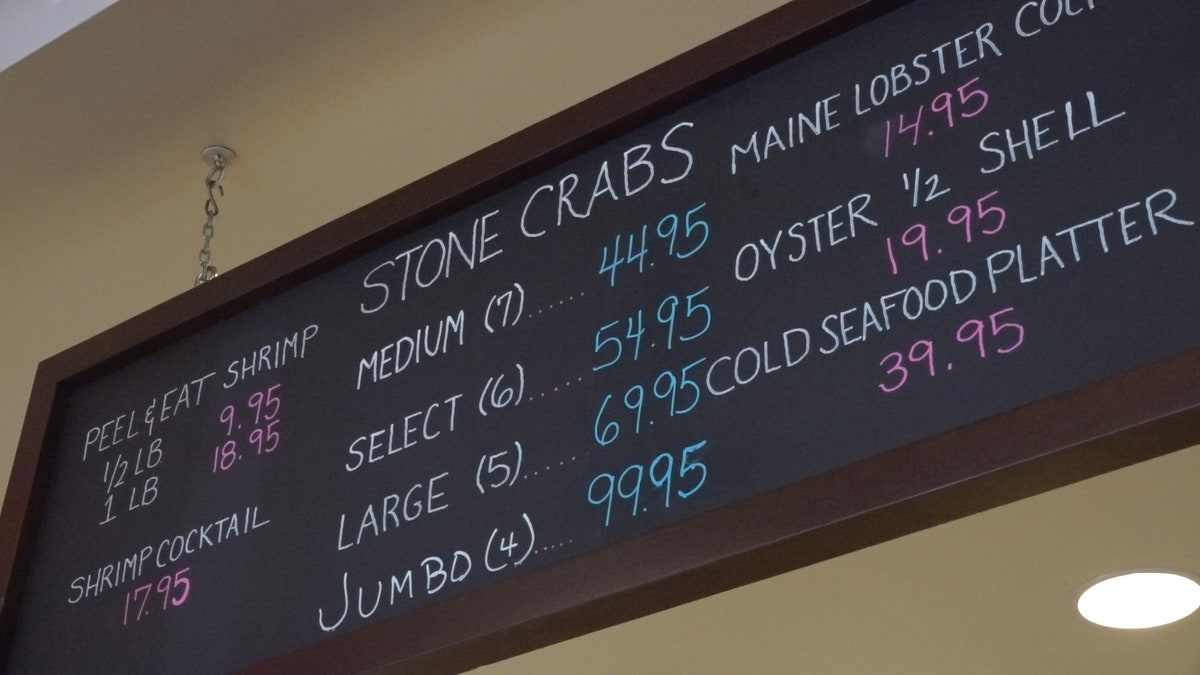Florida red tide hurts stone crab industry
{{#rendered}} {{/rendered}}PINE ISLAND, Fla. –– Florida’s months-long battle over red tide is hurting an industry critical to the region: stone crabs.
The state responsible for about 98 percent of the stone crabs hitting plates around the country is feeling the pain of the shellfish shortage, which is impacting everyone from consumers to business owners. Experts say the crabs are worth $31 million annually.
Joe’s Stone Crab restaurant in Miami Beach claims it started the stone crab craze almost a century ago, and now the restaurant's name is on the line. Stephen Sawitz, a senior executive at Joe’s, said skyrocketing prices could make the shellfish out of reach for many people.
{{#rendered}} {{/rendered}}CLICK HERE TO GET THE FOX NEWS APP
“They are up to $69.95 right now. That is a $10 increase, which is very big for us,” Sawitz said.
Sawitz said the problem is going to get worse because there simply are not enough crabs to go around. The number of stone crabs untouched by red tide is dipping quick, but the demand from customers is at an all-time high. This is bad news for businesses like Joe's, which is having an increasingly having a hard time putting crabs on the table.
{{#rendered}} {{/rendered}}
Resturants in Florida like Joe's Stone Crab in Miami Beach have seen prices steadily rise in recent months. (Elina Shirazi / Fox News)
“You can’t buy those crabs out the water,” said Sawitz.
Researchers are trying to pinpoint exactly how these crabs are dying and if they can be saved.
Red tide, which is impacting a large swath of the Florida coast, creates harmful toxins that are killing marine life and hurting local tourism. The algal blooms choking the coast also cause respiratory irritations in humans and potential skin rashes when swimmers enter the water.
{{#rendered}} {{/rendered}}Scientists say they are still trying to figure out the short-term and long-term impact of red tide.
“Work done so far has been relatively limited. It has been done in a laboratory and so we need to expand these kinds of experiments to really, really see, if there are any dangers to our own seafood safety, and what the ecological impacts are of red tide on these organisms,” said Greg Tolley, chair of the Department of Marine and Ecological Sciences at Florida Gulf Coast University.
Tampa, Sarasota, and Naples are among cities in Florida hit hard by red tide. (Fox News)
Tolley said red tide is basically cutting off oxygen to the seafloor, killing all the fish that depend on it.
{{#rendered}} {{/rendered}}Researchers said the toxic algae is not only destroying the crabs but also killing off their larvae. Some of the hardest hit areas include Tampa, Sarasota and Naples.
Fishermen are seeing this first hand. Eddie Barnhill, a third-generation fisherman in Pine Island, said the drop in stone crabs forced him to sell his business -- changing his career and way of life.
“You are born with saltwater in your veins, I would say. It takes a special person to go out and fight the weather we fight and do what we do on a daily basis to put that crab on the table for the people who enjoy it,” Barnhill said.
{{#rendered}} {{/rendered}}Platter of stone crabs about to be served at Joe’s Stone Crab. (Elina Shirazi / Fox News)
He said the problem could also hurt the next generation of fishermen, including his son.
"I am trying to talk him out of wanting to fish. Because I don’t see the future for it,” he said.
Those affected now question whether policymakers will step in to help soften this year’s impact. Gov. Ron DeSantis says he plans to live up to his campaign promise to clean up Florida’s waters.
{{#rendered}} {{/rendered}}Dead fish washed up on a Florida beach after red tide outbreak in the state. (Elina Shirazi / Fox News)
The governor’s office said his order includes directing the Florida Department of Health to participate in the Florida Fish and Wildlife Conservation Commission's Algal Bloom Task Force to provide technical expertise and assistance in studying the causes and impacts of red tide.
The Department of Health was also directed to study air quality and the human health impacts of red tide. The department will continue the red tide emergency grant program to support local governments in cleaning up their beaches and coastal areas to help minimize the impacts of the tide to residents and visitors.

